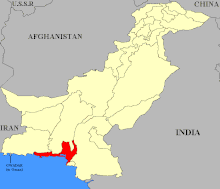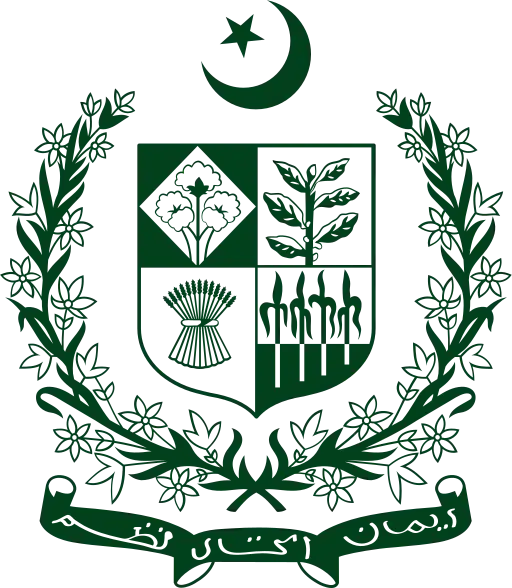| Las Bela | |
|---|---|
| Princely state of Pakistan | |
| 1742–1955 | |
 Flag | |
 Las Bela in Pakistan 1955 (in red) | |
_in_British_India_1940.png.webp) Las Bela in British India 1940 (in red) | |
| Capital | Bela |
| Area | |
• | 18,254 km2 (7,048 sq mi) |
| History | |
• Established | 1742 |
• Disestablished | 14 October 1955 |
| Today part of | Balochistan, Pakistan |
.jpg.webp)
 |
| This article is part of the series |
| Former administrative units of Pakistan |
|---|
Las Bela (Urdu: لسبیلہ) was a princely state in a subsidiary alliance with British India (later a princely state of Pakistan) which existed until 1955. The state occupied an area of 18,254 km2 (7,048 sq mi) in the extreme southeast of the Balochistan region, with an extensive coastline on the Arabian Sea to the south. Las Bela was bordered by the princely states of Kalat and Makran to the north and west. To the east lay the province of Sind and to the southeast lay the Federal Capital Territory around the city of Karachi.
History
The State of Las Bela was founded in 1742 by Jam Ali Khan I, who was from Rajput Jamote clan.[1][2] His descendants ruled Las Bela until 1955 when the state became part of West Pakistan. The statement of Ghulam Qadir Khan, the last Jam of Las Bela on signing the accession was:
We hold historical ties with Sindh and share strongest cultural bond with the Province. Our People have accepted Jinnah Sahab as the leader of new Muslim homeland and we vote to emerge in Pakistan.
For a period of three years between 3 October 1952 and 14 October 1955, Las Bela was part of the Baluchistan States Union but retained internal autonomy. In 1955, Las Bela was incorporated into the new province of West Pakistan and became part of Kalat division. In 1960, the area of Las Bela was detached from Kalat division and merged with the former Federal Capital Territory to form the division of Karachi-Bela. When the provincial system was changed in 1970, Las Bela became part of the new province of Balochistan.
Demographics
The main ethnic groups in Las Bela were Baloch. The population was mainly Muslim Balochs but there was a small population of Hindus. There were also nomadic Lasi people near the Sindh border.
Geography and climate
Las Bela has a hot, dry tropical desert climate. It is only a few degrees north of the Tropic of Cancer. The sea breezes though make the weather less extreme than inland Balochistan, where temperatures can reach 50 °C (122 °F) in the summer.
Rulers
The hereditary rulers of Las Bela were styled as Jam Sahib. The Jams of Lasbela are believed to have claimed their ancestry from the Samma of Sindh[3] who also used the title of Jam.
| Tenure | Jams of Las Bela[4] |
|---|---|
| 1742–1765 | Jam Ali Khan I (surnamed Koreja) |
| 1765–1776 | Jam Ghulam Shah |
| 1776–1818 | Mir Khan I |
| 1818–1830 | Ali Khan II |
| 1830–1869 | Mir Khan II (CIE, KCIE) (1st time) |
| 1869–1886 | Sir Ali Khan III (KCIE) (1st time) |
| 1886-1888 | Sir Mir Khan II (KCIE) (2nd time) |
| 1888-1896 | Sir Ali Khan III (2nd time) |
| 1896-1921 | Kamal Khan (CIE) |
| 1921-1937 | Ghulam Mohammad Khan (GCIE) |
| 1937-1955 | Ghulam Qadir Khan (CIE) |
| 14 October 1955 | State of Las Bela dissolved |
| 1955-1988 | Ghulam Qadir Khan (Jam of Lasbela) |
| 1988-2013 | Jam Mohammad Yousaf (Jam of Lasbela) |
| 2013-to date | Jam Kamal Khan (Jam of Lasbela) |
Prominent members of the family after the end of the princely state included:
- Jam Ghulam Qadir Khan former Chief Minister of Balochistan province.
- Jam Mohammad Yousaf former Chief Minister of Balochistan province.
- Jam Ali Akbar former Provincial Minister of Balochistan province.
- Jam Kamal Khan Former chief minister of Balochistan and speaker of provincial assembly of Balochistan.
See also
References
- ↑ Quddus, Syed Abdul (1990). The Tribal Baluchistan. Ferozsons. p. 63. ISBN 978-969-0-10047-4.
The former rulers of Makran and Lasbela, Gichki and Jamots respectively, are Rajputs.
- ↑ The Encyclopaedia of Islām: A Dictionary of the Geography, Ethnography and Biography of the Muhammadan Peoples. E. J. Brill. 1970. p. 632.
The leading tribes, which are probably of Rājpūt origin are the Djāmot, to which the Djām or ruler of Lasbela belongs...
- ↑ "Necropolis: City of silence". DAWN.COM. 11 April 2010.
The Jams of Lasbela are belived to have claimed their ancestry from Samma of Sindh who ruled over Sindh from 1351 to 1524. One of their ancestors Jam Araddin migrated from Sindh and settled in Kanrach during the reign of Mughal emperor Jahangir (1569-1627).
- ↑ Ben Cahoon, WorldStatesmen.org. "Pakistan Princely States". Retrieved 3 October 2007.